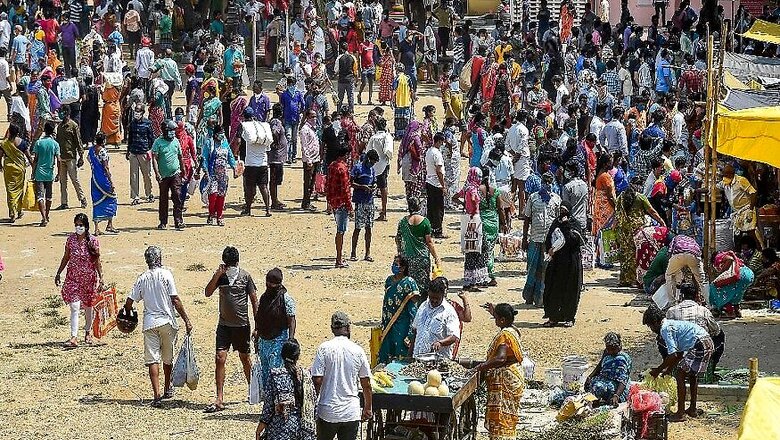
views
Chennai: Chennai has become the hotbed of Covid-19 in Tamil Nadu, accounting for more than half of the state's positive cases. The capital has a total of 3043 confirmed cases of the virus, while the state's tally stands at 6009 (as of morning on May 9).
While many other districts across Tamil Nadu, even ones which saw an initial spike, have managed to reduce cases, Chennai firmly remains in the red zone with 2644 active cases.
What are the factors affecting the spread of the virus in the city?
Two clusters - Tablighi Jamaat and Koyambedu market have thrown up a marked increase in the number of coronavirus cases in the city. Chennai first saw a rapid increase in cases in early April following the return of Tablighi Jamaat attendees from New Delhi. By morning of April 21, the city had more than 300 cases. The cases continued to increase in the next few days, with a massive spike beginning in May, with another cluster contributing plenty of positive cases: the Koyambedu vegetable market.
The first signs of the market turning into a coronavirus cluster emerged in the last week of April, but it was only on May 4 that the market was shut. Until then, plenty of small shops in the cramped area continued to operate, with little adherence to social distancing.
Contact tracing has proved difficult too, with workers also beginning to move to other districts in the state. The cluster has contributed not just to cases in Chennai; the government revealed on Friday that 1589 cases in the entire state were linked to Koyambedu cluster.
Lockdown within lockdown proves costly
The TN government had imposed a 'complete lockdown' for four days from April 26, enforcing stricter rules pertaining to movement of people. However, they had announced the same on April 24, leaving one day for people to shop for essentials. Public naturally thronged markets, stocking up for four days with social distancing norms going for a toss in many places. Pictures of crowded markets were out everywhere for all to see.
Perhaps realising the mistake, the government on April 25 announced that the shops could be open till 3pm instead of the usual 1pm, but the damage had already been done.
Increase in cases in central and south Chennai
The focus in the initial weeks was firmly on north Chennai, with the Tablighi Jamaat cluster and narrow lanes in the area contributing to cases. With more clusters emerging, the next few weeks has seen an increase in cases in the other regions too.
As of the morning on May 2, areas under central Chennai (Thiru Vi Ka Nagar, Ambattur, Anna Nagar, Teynampet and Kodambakkam) saw 631 cases. The number now stand at 1763. As of Saturday, the cases have spiked again to Thiru Vi Ka Nagar with 477, Ambattur at 164, Anna Nagar with 233, 343 in Teynampet and Kodambakkam throwing up 546 cases.
A large number of cases were from Thiru Vi Ka Nagar, but in recent weeks, Kodambakkam and Teynampet have emerged as hot-beds too due to the Koyambedu market cluster. In fact, Kodambakkam zone has the most cases in the city at 546, while Thiru Vi Ka Nagar has a total of 477.
Teynampet zone, with 343 cases, has also been a hot bed with plenty of cases from Triplicane, where volunteers who distributed food in VR Pillai street were not checked for symptoms, which ultimately led to 42 more positive cases in the area.
In south Chennai (Valasaravakkam, Adyar, Perungudi and Sholinganallur) had only 93 cases on May 2. Currently, the area has a staggering 453 cases.
As of Saturday, Valasaravakkam accounted for 256 cases, Adyar at 140, Perungudi counted 32 while Sholinganallur threw up 25 coronavirus cases.
While plenty of cases in Valasaravakkam zone are from the Koyambedu cluster, areas like Adyar too has seen a rapid increase. Adyar zone had 21 cases on May 1, which has shot up to 140 by Saturday.
The spike in south Chennai, Adyar zone in particular, has been attributed to Tiruvanmiyur market. The vegetable market saw massive crowds on April 25, a day before the 'lockdown within lockdown'. The market was shut on May 3 after a vendor tested positive, and all other workers were subsequently tested.
High testing rates
Tamil Nadu has tested more samples than any other state, including Maharashtra. The southern state has tested 2,16,416 samples as of Saturday, a majority of them from Chennai. While district-wise numbers haven't been made public, the Chennai Corporation on May 1 said they're testing 5225 people per million population. Tirupatur district, with 3195 per million, comes next.




















Comments
0 comment